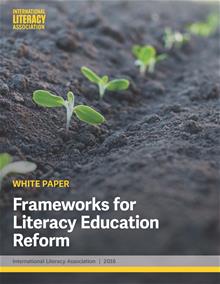ILA developed Frameworks for Literacy Education Reform in response to today’s complex and evolving education landscape. With an increase in English learners, high-stakes testing, and digital technologies driving new modes of teaching and learning, challenges for the classroom teacher are mounting. The new white paper’s frameworks serve as a high-level rubric that school administrators and policymakers can use to create or assess reform proposals. In this blog series, we’ll take a closer look at each of the frameworks.
 Each child enters school with a different early childhood experience, which has an impact on his or her literacy readiness and the factors that classroom educators need to take into consideration when evaluating students. To accommodate the diversity educators face in the classroom, the mixture of families and communities has to be taken into consideration to increase better literacy outcomes.
Each child enters school with a different early childhood experience, which has an impact on his or her literacy readiness and the factors that classroom educators need to take into consideration when evaluating students. To accommodate the diversity educators face in the classroom, the mixture of families and communities has to be taken into consideration to increase better literacy outcomes.
School policies need to be inclusive, for example, identifying how to accommodate native cultures (including mother tongues) and taking the neighborhood and socioeconomic status into consideration.
“Specifically, family instability, trauma, violence, and community unrest (e.g. St. Louis, Baltimore, other cities that have experienced unrest) are some of the impactful factors for students,” said Sue Sharma, the lead writer on the families and community framework of the Frameworks for Literacy Education Reform and a visiting assistant professor at Oakland University. “The needs of families that affect literacy achievement need to be acknowledged by those in a position of power to have a positive influence.”
Beyond the home, businesses and corporations can play a critical role in supporting schools.
“For example, literacy demands continually change because of society and technology,” said Sharma. “We feel that business can contribute in meaningful ways. There are many examples of successful partnerships that create a sense of community critical to advancing literacy initiatives in schools,” she added. Sharma cautioned that students are not widgets in factories so their challenges are not all remedied with a packaged solution. However, a healthy balance and respect can lead to positive outcomes.
Some ways businesses can contribute include being a community center, a place that encourages literacy development for students and their families, and increasing investment via charitable and non-profits to work with public agencies for literacy advancement.
Finally, having the buy-in of local government officials can bring the monetary power schools need to counteract community challenges or disparities.
Investments include making successful, literacy-rich programs accessible to all families, regardless of socioeconomic status; providing tax incentives to local organizations and businesses who invest in literacy achievement in urban areas; and flat-out funding literacy education programs.
The trinity of schools, businesses, and local government that supports families for the sake of student literacy will be integral to education reform and can be not only a safety net for families who feel left out of the system, but also a bridge that leads them through the process of literacy acquisition.
The complete white paper, Frameworks for Literacy Education Reform, can be found here.
April Hall is editor of Literacy Daily. A journalist for 20 years, she has specialized in education, writing and editing for newspapers, websites, and magazines.